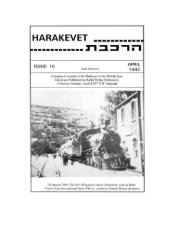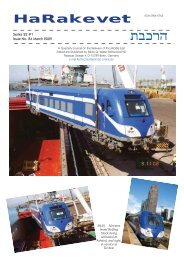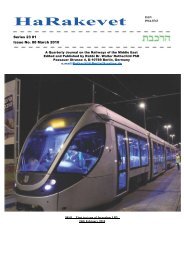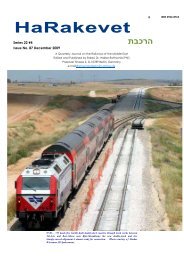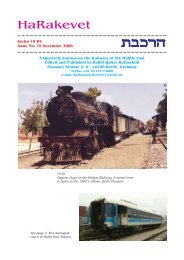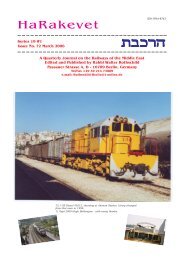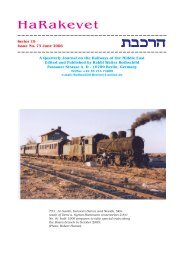Welcome to Issue 7. This has been a long time in ... - HaRakevet
Welcome to Issue 7. This has been a long time in ... - HaRakevet
Welcome to Issue 7. This has been a long time in ... - HaRakevet
You also want an ePaper? Increase the reach of your titles
YUMPU automatically turns print PDFs into web optimized ePapers that Google loves.
<strong>7.</strong> REVIEW:"RAKEVET HA' EMEK"(The Vallev Railway",by David Tirosh.<br />
Published (In Hebrew) by The Society for the Protection of<br />
Nature <strong>in</strong> Israel. 99 pages. Price NIS 18.<br />
Reviewed by Sybil Ehrlich.<br />
<strong>This</strong> very attractive little book is packed with <strong>in</strong>formation on<br />
the Jezreel Valley Railway, which ran from Haifa <strong>to</strong> Damascus<br />
between 1905 and 1948. it conta<strong>in</strong>s chapters on the plann<strong>in</strong>g and<br />
construction of the l<strong>in</strong>e, rem<strong>in</strong>iscences of old-<strong>time</strong>rs who worked<br />
on it or lived <strong>in</strong> the villages served by it <strong>in</strong> the 1930's and<br />
1940's, and amus<strong>in</strong>g anecdotes which entered Israeli folklore,<br />
such as the joke about the man who decided <strong>to</strong> commit suicide,<br />
lay down on the tracks of the Valley Railway, no<strong>to</strong>rious for its<br />
erratic <strong>time</strong>keep<strong>in</strong>g, and eventually died of starvation!<br />
The book is <strong>in</strong>tended for the general reader who is<br />
<strong>in</strong>terested <strong>in</strong> explor<strong>in</strong>g the country and its recent past. Anyone<br />
expect<strong>in</strong>g tables of locomotives and technical details might be<br />
disappo<strong>in</strong>ted!<br />
One chapter, "A Tour of the L<strong>in</strong>e", gives the his<strong>to</strong>ry of the<br />
24 stations and other features of the section of the l<strong>in</strong>e <strong>in</strong><br />
present-day Israel, and a description of what rema<strong>in</strong>s of each<br />
<strong>to</strong>day. Some stations which were no more than a sign board have<br />
disappeared without trace, but others are remarkably wellpreserved.<br />
For example, one of the complex of five station<br />
build<strong>in</strong>gs at Afula now houses a public library, and the station<br />
at Kfar Yehoshua was res<strong>to</strong>red for the village's 60th.<br />
anniversary <strong>in</strong> 198<strong>7.</strong><br />
There are several sketch maps and reproductions of old<br />
plans, letters and <strong>time</strong>tables, <strong>in</strong> English and Hebrew, as well as<br />
49 pho<strong>to</strong>graphs, ancient and modern, <strong>in</strong>clud<strong>in</strong>g 12 <strong>in</strong> full colour.<br />
One colour pho<strong>to</strong> depicts an unusual water <strong>to</strong>wer at Tzemach,<br />
built of the black basalt s<strong>to</strong>ne typical of the area.<br />
Perhaps the most extraord<strong>in</strong>ary fact about the Valley Railway<br />
is that Israel Railways, which now owns the land, <strong>has</strong> never<br />
permitted any build<strong>in</strong>g on it. Accord<strong>in</strong>g <strong>to</strong> David Tirosh, the<br />
Beit She'an Local Coumncil <strong>has</strong> even discussed (January 1988)<br />
with the M<strong>in</strong>istry of Tourism the possibility of res<strong>to</strong>r<strong>in</strong>g<br />
services from Afula <strong>to</strong> Beit She'an as part of a plan <strong>to</strong> develop<br />
<strong>to</strong>urism <strong>in</strong> the area. We can but hope!<br />
(Edi<strong>to</strong>r's Note: Hav<strong>in</strong>g traversed most of the route myself <strong>in</strong><br />
1981, I can vouch for the excellence and thoroughness of<br />
Tirosh's pho<strong>to</strong>graphic survey. However, part of the l<strong>in</strong>e between<br />
Tel Hanan and the Kishon river bridge <strong>has</strong> now <strong>been</strong> absorbed <strong>in</strong> a<br />
road-widen<strong>in</strong>g scheme.<br />
One day someone should do a PhD on the orig<strong>in</strong>s of the jokes<br />
about the Rakevet HaEmek. Some of them have parallels with Jokes<br />
about the Württemberg State Railways, the Southwold Railway,<br />
American branch l<strong>in</strong>es - <strong>in</strong> short, they might reflect the humour<br />
of the various immigrants ! When did each first appear? What are<br />
the folkloristic parallels with the railroad humour of Upper<br />
Nebraska ? The possibilities for pompous research are endless..)<br />
Thanks <strong>to</strong> Alon Si<strong>to</strong>n for this special<br />
post-mark commemorat<strong>in</strong>g the open<strong>in</strong>g<br />
of the l<strong>in</strong>e <strong>to</strong> Beer Sheba on 29th.<br />
Sept. 1956.<br />
Clearly this is meant <strong>to</strong> be a<br />
representation of the Essl<strong>in</strong>gen<br />
diesel railcar sets.



